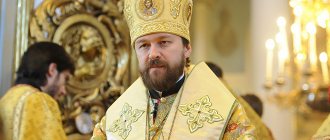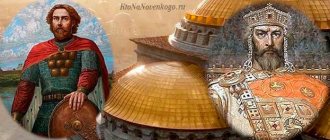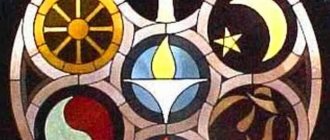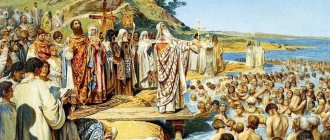Fundamentals of Christianity: what is the essence of religion
According to surviving documentary sources, Christianity originated in the 1st century AD, in the territory of modern Palestine. Born in Nazareth, into a simple family of a potter, the preacher Jesus Christ brought a new teaching to the Jews - about one God. He called himself the son of God, whom the Father sent to people to save them from sin. The teaching of Christ was a teaching about love and forgiveness. He preached nonviolence and humility, confirming his beliefs by his own example. The followers of Jesus were called Christians, and the new religion was called Christianity. After the crucifixion of Christ, his disciples and supporters spread the new teaching throughout the Roman Empire, and soon throughout Europe.
In Rus', Christianity appeared in the 10th century. Before this, the religion of the Russians was paganism - they deified the forces of nature and worshiped them. Prince Vladimir, having married a Byzantine woman, accepted her religion. Despite the resistance that arose everywhere, soon all of Rus' underwent the rite of baptism. Gradually, the old faith was forgotten, and Christianity began to be perceived as an original Russian religion. Today there are more than 2 billion followers of the teachings of Christ in the world. Among them, approximately 1.2 billion consider themselves to be Catholic, about 0.4 billion are Protestant, and 0.25 billion are Orthodox. Many wear silver crosses.
The Essence of God as Seen by Christians
According to the Old Testament (original) Christian faith, God is one in his appearance. He is the beginning of everything and the creator of all living beings. This perception of God was a dogma - the only true and inviolable position approved by the church. But in the 4th-5th centuries a new dogma appeared in Christianity - the Trinity. Its compilers presented God as three hypostases of one essence:
- God the Father;
- God the Son;
- God is the Holy Spirit.
All entities (Persons) are equal and come from one another. The new addition was actively rejected by representatives of Eastern faiths. In the 7th century, the Western Christian Church officially adopted the filioque, an addition to the Trinity. This was the impetus for the split of the United Church.
In the view of religion, man is a creation of God, and he is not given the opportunity to know the essence of his creator. Questions and doubts are taboo for a true Christian believer. Everything that a person should and can know about God is set out in the Bible, the main book of Christians. It is a kind of encyclopedia containing information about the formation of religion, descriptions of historical events before the appearance of Jesus and key moments in his life.
Emergence
The creation and development of a new world religion has a complicated history. The emergence of Christianity is shrouded in secrets, legends, assumptions and assumptions. Not much is known about the establishment of this doctrine, which today is professed by a quarter of the world's population (about 1.5 billion people). This can be explained by the fact that in Christianity, much more clearly than in Buddhism or Islam, there is a supernatural principle, belief in which usually gives rise to not only reverence, but also skepticism. Therefore, the history of the issue was subject to significant falsification by various ideologists.
In addition, the emergence of Christianity and its spread was explosive. The process was accompanied by active religious, ideological and political struggle, which significantly distorted the historical truth. Disputes on this issue continue to this day.
The God-Man: Who Was Jesus?
The doctrine of the God-man - Christology - tells about Jesus, both as the incarnation of God and as the son of God. He is a man because his mother is a human woman, but he is like God because his father is the One God. At the same time, Christianity does not consider Jesus a demigod, and does not classify it as a prophet. He is the only unique incarnation of God on Earth. There cannot be a second person like Jesus, because God is infinite and cannot be incarnated twice. The appearance of Jesus was predicted by the prophets. In the Old Testament he is presented as the Messiah - the savior of mankind.
After the crucifixion and physical death, the human hypostasis of Jesus became incarnate into the divine. His soul united with the Father in Paradise, and his body was consigned to the earth. This paradox of Jesus the man and Jesus the God is expressed in the Ecumenical Council by the formula of 4 negations:
- unmerged;
- unconverted;
- inseparably;
- inseparable.
The orthodox branches of Christianity revere Jesus as the God-man - an entity who embodied divine and human characteristics. Arianism reveres him as a creation of God, Nestorianism - as two separate entities: divine and human. Those who profess Monophysitism believe in Jesus the God who absorbed his human nature.
The appearance of the name “Orthodoxy”
The very name “Orthodoxy” is literally translated from Greek as “correct glorification” or “correct opinion.” In theological literature, the term denotes the teaching approved by the Catholic Church; its opposite is “heterodoxy” or “heterodox,” that is, the views of heretics or those that the Church rejected.
The word “Orthodoxy” itself was mentioned already in the 2nd century in the texts of apologists (successors of the apostles), for example, in Clement of Alexandria. As a term, it was established in the 3rd century by the historian and bishop Eusebius of Caesarea, and was first officially recorded in the middle of the 5th century in the acts of the IV Ecumenical Council. Beginning in the 6th century, Orthodoxy began to designate religious views that closely correspond to the teachings of the Church and the Gospel.
In Rus', the term appears in several early written sources:
- In the story of Bygone Years as part of the Laurentian Chronicle (1377).
- In an early copy (copy) of “The Sermon on Law and Grace” (early 11th century) by Metropolitan Hilarion. A copy was made in the second half of the 15th century.
Interesting fact: in Russian, the terms “Orthodoxy” and “Orthodox” are synonymous and are not used simultaneously, as, for example, in Judaism.
Anthropology: the origin of man and his purpose
Initially, man was created in his image of God, and possesses his power. The originals Adam and Eve were similar to their Creator, but they committed the original sin - they succumbed to temptation and ate an apple from the tree of knowledge. From that moment on, man became sinful, and his body was perishable.
But the human soul is immortal and can go to Paradise, where God is waiting for it. To be in Paradise, a person must atone for his sin through physical and spiritual suffering. In the Christian understanding, evil is temptation, and good is humility. Suffering is a way to fight evil. Ascent to God and return to one's original essence is possible only through humility. It leads to freedom of spirit and understanding of the true essence of life. For people who succumb to temptation, Hell awaits - the kingdom of Satan, in which sinners eternally suffer, paying for their sins.
What are the sacraments
There is a unique concept in the Christian faith - sacrament. It arose as a definition of a special action that cannot be attributed to either rites or rituals. Only God can know the true essence of the sacrament; it is not accessible to man due to his imperfection and sinfulness.
The most important sacraments: baptism and communion. The first is the initiation of the believer, introducing him into the number of God-pleasing people. The second is connecting with the essence of Jesus by eating the sacred bread and wine, symbolizing his flesh and blood.
Orthodoxy and Catholicism recognize five more sacraments:
- anointing;
- ordination;
- repentance;
- marriage;
- Unction.
Protestantism denies the sacredness of these phenomena. This branch is also characterized by a gradual abandonment of asceticism, as the only way for a person to get closer to the divine essence.
The role of the monarchy in the formation of religion
The official state religion of Rome was paganism, which involved the deification of the current emperor. The new teaching was received with hostility. Persecution and prohibitions have become part of the history of religion. Christianity was forbidden not only to profess, but also to remember its existence. Preachers were subjected to torture, life imprisonment or the death penalty. But adherents of Christianity revered them as martyrs, and every year Christianity spread more and more actively.
Already in the 4th century, Emperor Constantine was forced to recognize the new belief. The pagans staged riots to protest against the emperor's interference in the affairs of the Church. Christians went into the desert and organized monastic settlements there. Thanks to this, nomads learned about the new religion. Christianity gradually spread to other countries.
The emperor's power was weakening. The abbot of the Roman Church, the Pope, declared himself the sole representative of the religion, and the rightful ruler of the Roman Empire. Attempts to find a balance between the desire for power and the preservation of the Christian way of life became the main moral dilemma for representatives of high church rank.
Acts of the Messiah
Growing up, Jesus adopted his father’s experience, became a mason and carpenter, and after Joseph’s death he fed and took care of the family. When Jesus was 30 years old, he met John the Baptist and was baptized in the Jordan River. Subsequently, he gathered 12 disciples-apostles (“envoys”) and, walking with them for 3.5 years around the cities and villages of Palestine, preached a completely new, peace-loving religion.
In the Sermon on the Mount, Jesus established moral principles that became the basis for the worldview of the new era. At the same time, he performed various miracles: he walked on water, raised the dead with the touch of his hand (three such cases are recorded in the Gospels), and healed the sick. He could also calm a storm, turn water into wine, and feed 5,000 people with “five loaves and two fishes.” However, Jesus was going through a difficult time. The emergence of Christianity is associated not only with miracles, but also with the suffering that he experienced later.
Key points of ancient religion: the schism of the Church
The reason for the split of Christianity into three conflicting faiths was the debate about the union of the divine and human essence of Jesus Christ into one person. Due to cultural and historical differences, there was constant debate among followers about the need to choose one official version. The growing conflict led to a division into denominations, each of which adhered to its own version.
In 1054, Christianity split into Orthodox and Catholic branches. Attempts to unite them again into one Church were unsuccessful. An attempt at unification was an agreement on the unification of churches on the territory of the Polish-Lithuanian Commonwealth - the Union of Brest, signed in 1596. But in the end, the conflict between faiths only intensified.
Popular message topics
- Leeches
The healing properties of leeches have been known to mankind for several millennia; using them for bloodletting, it was believed that they could cure many diseases. Currently, the use of leeches in alternative medicine - Cloudberry
Most perennial herbaceous plants, which include berries, have their own characteristics and are a subject of interest to people. - Tolerance
Tolerance is, first of all, tolerance. Tolerance for other people's views and interests, regardless of personal preferences. If we talk about terminology, the word “tolerance” comes from the Latin “tolerantia”,
Modern times: the crisis of Christianity
In the 16th century, world Christianity experienced a series of military conflicts. The churches sought to supplant each other. Humanity entered the Age of Enlightenment: religion was subjected to severe criticism and denial. The search began for new models of human self-awareness, independent of Biblical doctrines.
The innovators opposed the progress of Christianity - gradual development, the transition from simple to complex. Based on the idea of progress, Charles Darwin would later develop a theory of evolution based on scientific facts. According to it, man is not a creation of God, but the result of an evolutionary process. Since the 17th century, science and religion have been in constant conflict.
In the 20th century, in the post-revolutionary Soviet Union, Christianity was going through a period of strict prohibitions and categorical denial of the religious view of the world. Church ministers renounce their ranks, churches are destroyed, and religious books are burned. Only with the collapse of the USSR did religion gradually regain its right to exist, and freedom of religion became an inalienable human right.
Modern Christianity is not a totalitarian religious belief. Christians are free to accept baptism or refuse to follow its traditions. Since the mid-20th century, the idea of reuniting the three faiths into a single belief has been promoted as an attempt to avoid the extinction of religion. But none of the Churches is taking concrete action and the denominations are still divided.









